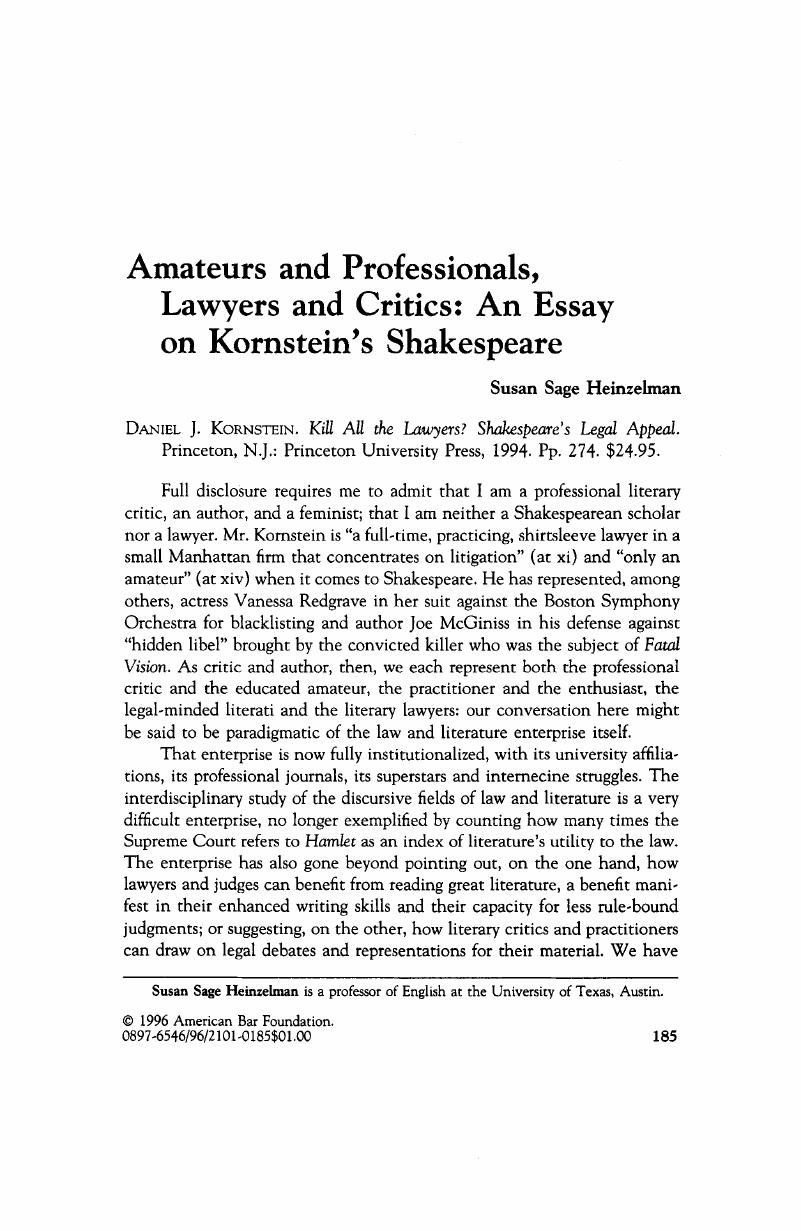No CrossRef data available.
Article contents
Amateurs and Professionals, Lawyers and Critics: An Essay on Kornstein's Shakespeare
Published online by Cambridge University Press: 27 December 2018
Abstract

- Type
- Review Essay
- Information
- Copyright
- Copyright © American Bar Foundation, 1996
References
1 See James Boyd White's The Legal Imagination (Boston: Little, Brown, 1973), and, most recently, id., Creating Authority in Law, Literature and Politics (Chicago: University of Chicago Press, 1994); Robert Ferguson's Law and Letters in American Culture (Cambridge: Harvard University Press, 1984); Richard Weisberg's The Failure of the Word (New Haven, Conn.: Yale University Press, 1984), and id., Poethics: And Other Strategies of Law and Literature (New York: Columbia University Press, 1992); and Richard Posner's Law and Literature: A Misunderstood Relationship (Cambridge: Harvard University Press, 1988) (“Posner, Law and Literature”).Google Scholar
2 478 U. S. 196 (1986).Google Scholar
3 See Stanley Fish's Doing What Comes Naturally: Change, Rhetoric, and the Practice of Theory in Literary and Legal Studies (Durham, N. C.: Duke University Press, 1989), and id., There's No Such Thing as Free Speech, and It's a Good Thing Too (New York: New York University Press, 1994); Steven Mailloux's Interpreting Law and Literature: A Hermenutic Reader, ed. with Sanford Levinson (Evanston, Ill.: Northwestern University Press, 1988); Drucilla Cornell's Beyond Accommodation (New York: Routledge, 1991), and id., Transformations (New York: Routledge, 1993); and Patricia J. Williams's Alchemy of Race and Rights (Cambridge: Harvard University Press, 1991).Google Scholar
4 The classic statement of this relationship between the artist, the world and representation comes in Wordsworth's Preface to Lyrical Ballads first published in 1798 where Wordsworth speaks of “all good poetry [as]… the spontaneous overflow of powerful feelings” (William Wordsworth, “Preface to Lyrical Balirds,” in John Hayden, ed., Selected Prose 283 (New York: Viking Penguin, 1988). He also remarks, however, that this spontaneity “takes its origin from emotion recollected in tranquillity” (id. at 297). The critique of spontaneity as an aesthetic and moral value occurs in chapter 4 of Coleridge's Biographia Literaria (1817), where he distances himself from the association of authenticity with spontaneity. Samuel Taylor Coleridge, Biographia Literaria, ed. by James Engell & W. Jackson Bate (Princeton, N. J.: Princeton University Press, 1983). Coleridge's poetry had appeared, with Wordsworth's, in the Lyical Ballads. Google Scholar
5 Ann Thompson, “The Ethnic Perspective,” Times Lit. Supp. 28 July 1995, at 24.Google Scholar
6 Id. Emphasis in original.Google Scholar
7 Posner, Law and Literature 78.Google Scholar
8 See, for example, Kenneth Burke's analysis of Greek tragic drama in Language as Symbolic Action 129 (Berkeley: University of California Press, 1966), where he argues that in the Eumenides “we are… witnessing the ‘first’ trial for murder as contrasted with the earlier feudal practice whereby the victim was avenged by kinsmen.” See also Burkert's, Walter Structure and History in Greek Mythology and Ritual (Berkeley: University of California Press, 1979), and John B. Vickery's The Scapegoat in Ritual and Literature (Cambridge: Harvard University Press, 1971).Google Scholar
9 Richmond Barbour, “‘When I Acted Young Antinous’: Boy Actors and the Erotics of Jonsonian Theater,” 5 Pubs. Mod. Language Soc'y 1006, 1008 (Oct. 1995).Google Scholar
10 M. M. Mahood, ed., “Introduction,”The Merchant of Venice 17 (Cambridge: Cambridge University Press, 1987).Google Scholar
11 Id. Google Scholar




